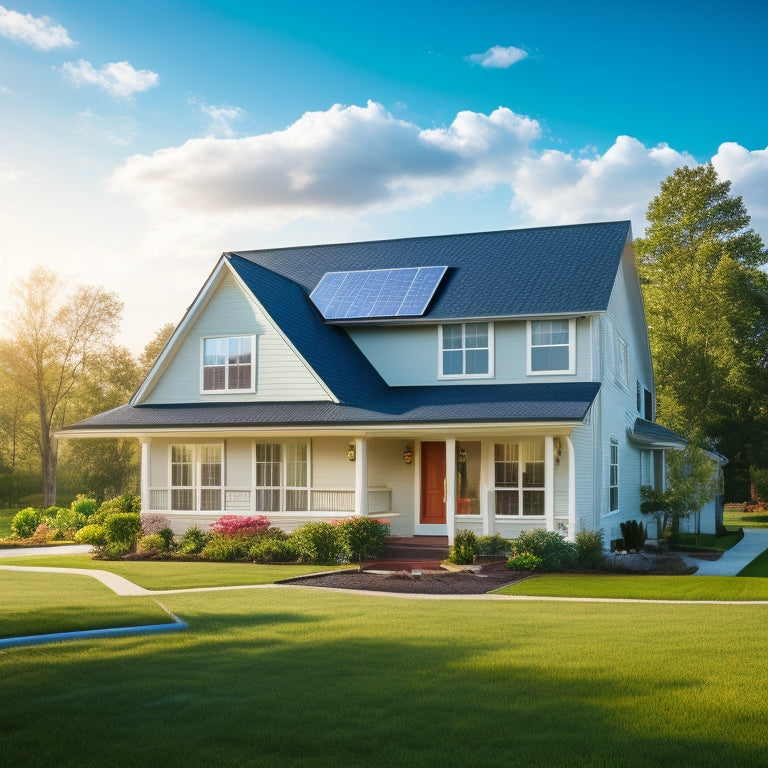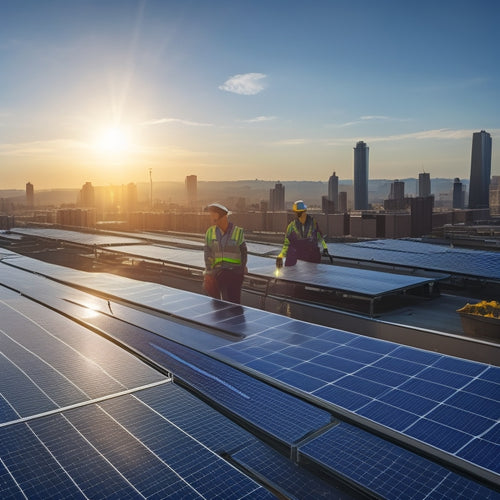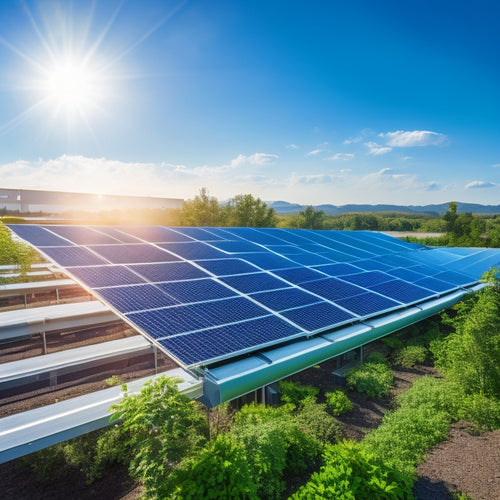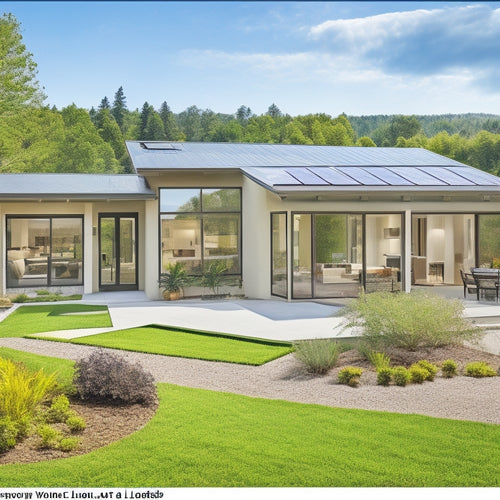
Lowering the Cost of Installing Solar Panels at Home
Share
You can greatly reduce the upfront cost of installing solar panels at home, which typically ranges from $15,000 to $30,000, by leveraging federal tax credits, local incentives, and financing options. For instance, the federal tax credit can reduce upfront costs by 30%, and local rebates can further decrease overall costs. Additionally, choosing the right solar panels, optimizing your roof space, and working with affordable installers can also help lower installation costs. By understanding the various aspects of solar panel installation, you can make informed decisions to minimize your expenses and maximize your long-term energy savings - and there's more to investigate on this topic.
Key Takeaways
- The federal tax credit can reduce upfront costs by 30%, decreasing to 26% until 2022, making solar panels more affordable.
- Financing options with little to no upfront costs are available, allowing homeowners to invest in solar energy without breaking the bank.
- Choosing the right solar panels with high efficiency ratings and durable materials can provide long-term energy savings and reduce overall costs.
- Optimizing roof space and orientation can increase energy output, reducing the number of panels needed and subsequently lowering installation costs.
- Researching and comparing quotes from local installers can help homeowners find the best deals and avoid overpaying for solar panel installation.
Understanding Solar Panel Costs
When evaluating a solar panel installation, one of the primary concerns is often the upfront cost. You're likely wondering how much it'll set you back and whether the investment is worth it.
The good news is that while the initial cost may seem steep, solar panels can provide significant long-term energy savings.
The total cost of a solar panel system includes the panels themselves, installation, and other equipment. You can expect to pay between $15,000 and $30,000 for a typical residential system.
However, solar panel financing options are available to help make the shift more affordable. Many providers offer financing plans with little to no upfront costs, allowing you to start saving on your energy bills right away.
In addition to the initial cost, it's crucial to examine the long-term benefits of solar panels. With energy savings ranging from $400 to $1,000 per year, depending on your location and energy usage, solar panels can pay for themselves over time.
Choosing the Right Solar Panels
You've decided to take the leap and invest in solar panels, and now it's time to select the right ones for your needs. With so many options available, it's crucial to understand the different solar panel types and their efficiency ratings to make an informed decision.
When choosing the right solar panels, consider the following factors:
-
Monocrystalline vs Polycrystalline panels: Monocrystalline panels are more efficient but also more expensive, while polycrystalline panels offer a lower upfront cost.
-
Efficiency ratings: Look for panels with high efficiency ratings (above 20%) to maximize energy production.
-
Wattage: Calculate your energy needs and choose panels with the appropriate wattage to meet those needs.
-
Durability: Assess the panel's durability and warranty offered by the manufacturer.
-
Certifications: Verify the panels meet industry standards and have necessary certifications (e.g., UL, IEC).
Optimizing Your Roof Space
When optimizing your roof space for solar panels, you'll want to maximize energy production by strategically placing panels to capture the most sunlight.
Evaluating your roof's orientation is essential, as a south-facing roof receives the most sunlight throughout the day.
Maximize Energy Production
How can you squeeze the most energy out of your solar panel system? To maximize energy production, it's essential to enhance your roof space. This involves strategically placing your solar panels to guarantee they receive the most sunlight possible.
Here are some tips to help you maximize your solar energy efficiency:
-
Orient panels towards the correct direction: Verify your panels face the correct direction to capture the most sunlight. In the northern hemisphere, this typically means facing south.
-
Avoid shading: Keep trees, buildings, and other obstacles from casting shadows on your panels, as this can greatly reduce panel performance.
-
Use a monitoring system: Install a monitoring system to track your energy production and identify areas for improvement.
-
Clean your panels regularly: Dirt and debris can reduce your solar energy efficiency, so clean your panels regularly to maintain peak performance.
-
Consider using high-efficiency panels: Invest in high-efficiency panels to generate more power per hour of sunlight.
Assess Roof Orientation
Optimizing your roof space is essential for maximizing solar energy production. When evaluating your roof's orientation, you should consider the roof pitch, weather conditions, and direction. These factors will impact the performance of your solar panels.
| Roof Direction | Ideal Roof Pitch | Energy Output |
|---|---|---|
| South-facing | 30-40° | High |
| West-facing | 20-30° | Medium |
| East-facing | 20-30° | Medium |
| Flat | 10-20° | Low |
| North-facing | Not recommended | Very Low |
As shown in the table, south-facing roofs with a pitch between 30-40° are ideal for solar energy production. This orientation receives the most direct sunlight throughout the day. However, if your roof doesn't meet these conditions, don't worry. You can still generate significant energy with west- or east-facing roofs. Keep in mind that weather conditions, such as shading or extreme temperatures, can also affect energy output. By understanding your roof's orientation, you can optimize your solar panel installation and maximize your energy production.
Minimize Shading Issues
Minimize Shading Issues (Optimizing Your Roof Space)
Identifying and addressing shading issues is essential to maximizing your solar energy production. You'll want to minimize shading effects to guarantee your solar panels operate at peak efficiency.
To optimize your roof space, consider the following:
-
Conduct a shading analysis: Use tools or consult with a professional to identify areas of your roof that receive shade throughout the day.
-
Trim trees and shrubs: Regular maintenance can help reduce shading effects from foliage.
-
Optimize plant placement: Strategically place plants or trees to minimize shading on your solar panels.
-
Consider a solar panel cleaning schedule: Regular cleaning can help maintain efficiency, especially in areas with high tree debris or dust.
-
Design your system around obstructions: Work with your installer to design a system that accommodates existing obstructions, such as vents or skylights, to minimize shading effects.
Incentives and Tax Benefits
As you contemplate installing solar panels, you're likely wondering how to make the process more affordable.
Fortunately, there are various incentives and tax benefits available to help reduce the cost. The federal government offers a 30% tax credit on the total cost of your solar panel system, which can greatly lower your upfront expenses.
Additionally, many states provide rebates and financing options to encourage homeowners to switch to solar energy. You may also be eligible for solar grants, which can further reduce the cost of installation.
Utility programs and energy efficiency initiatives can also provide financial incentives for homeowners who invest in solar panels.
Another option to ponder is solar leasing, which allows you to rent a solar panel system and benefit from the energy it produces without incurring the initial installation costs.
DIY Solar Panel Installation
You've weighed the pros and cons of hiring a professional installer versus tackling the job yourself, and you've decided to take the DIY route for your solar panel installation.
This approach can greatly reduce your upfront costs, but it requires careful planning and execution.
Here are the essential components you'll need to get started:
- A solar panel kit that includes the necessary hardware and components
- Installation tools, such as a drill, wrench, and wire cutters
- A safe and stable ladder or roof access equipment
- A thorough understanding of your local building codes and regulations
- A willingness to invest time and effort into the installation process
Working With Affordable Installers
If DIY solar panel installation isn't your cup of tea, working with affordable installers can be a cost-effective alternative.
You'll still need to do your due diligence to confirm you're getting the best deal. Research local installers and compare quotes to find the most budget-friendly options. Be wary of extremely low prices, as they may indicate subpar quality or inexperience.
When evaluating installers, consider their qualifications, certifications, and reputation. Look for installers certified by the North American Board of Certified Energy Practitioners (NABCEP) or licensed by the state.
Check online reviews, ask for referrals, and verify their physical address and business licenses. A reputable installer will provide a thorough assessment of your energy needs, recommend the most suitable system, and confirm a smooth installation process.
Frequently Asked Questions
How Long Does It Take to Install Solar Panels on My Home?
You'll typically wait 1-3 days for a standard solar panel installation, but the timeline varies depending on installation factors like roof size, panel quantity, and local permits, so it's crucial to plan ahead and discuss the installation timeline with your provider.
Can I Add Solar Panels to My Existing Roof?
You're wondering if you can add solar panels to your existing roof, but first, you'll need to assess your roof structure's integrity and guarantee it can support the weight and stress of solar panels, and then determine solar panel compatibility with your roof's size and material.
Do Solar Panels Work During Power Outages?
You're wondering if solar panels work during power outages; unfortunately, they typically don't, as they're grid-tied and shut off for safety reasons. However, you can opt for a battery backup system, which stores excess energy for backup power, ensuring you have power during outages, maximizing your solar panel efficiency.
Will Solar Panels Increase My Property Value?
When you install solar panels, you'll likely increase your property value, which may lead to higher property tax assessments, but the long-term benefits, such as increased resale value, will likely outweigh the additional costs, making your home more attractive to potential buyers.
Can I Sell Excess Energy Back to the Grid?
As you capture the power of the sun like a modern-day alchemist, you'll be thrilled to know you can sell excess energy back to the grid through net metering benefits and energy buyback programs, offsetting your utility bills and maximizing your investment.
Conclusion
You've charted a course to utilize the sun's energy, and now you're ready to reap the rewards. Think of your solar panel installation as a puzzle - you've found the right pieces (panels, roof space, and incentives) and now it's time to put them together. With a little DIY elbow grease or the help of an affordable installer, you'll be generating clean energy in no time. As the pieces fall into place, you'll be basking in the glow of savings and a reduced carbon footprint.
Related Posts
-

Solar Installation Guide for Commercial Properties
Implementing solar energy solutions in your commercial property can lead to significant long-term savings and sustain...
-

Solar Energy Efficiency Improvements for Businesses
Improving solar energy efficiency for your business can lead to considerable cost savings and enhance your sustainabi...
-

Passive Solar Design Strategies for Homes
To effectively implement passive solar design strategies in your home, focus on ideal building orientation and strate...


